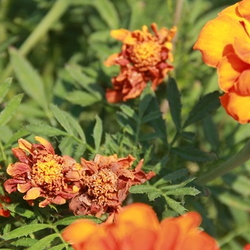(Editor's Note: This article was originally published on August 10, 2007. Your comments are welcome, but please be aware that authors of previously published articles may not be able to promptly respond to new questions or comments.)
Many gardeners do not think of deadheading as an art, but see it rather as a chore. One woman even told me wearily exactly how many daffodils she had deadheaded, ”One thousand eight hundred and seventy-three.” This is not a healthy attitude.
Let’s see, oh, yes, healthy attitudes. Sorry, I, um, well, I was deadheading some pansies, and pulling some little weeds, seeing about a nice rock for the new heather.
You see, when you are deadheading, you are tending to your garden in a most intimate way. To deadhead a flower, you must look at it and at the plant it is growing on. You notice the plant’s health, how well it is doing in regards to the plants around it and the state of the weed population. The choices you make about whether or not to leave a seed pod, how this little plant might be happier two feet closer to the partial shade rather than in the full sun, and if perhaps you can impose on a friend to take some sweet william seedlings off your hands are most easily done while you are observing all your plants from the perspective of relieving them of those dead flower heads.
Well, now, back from shearing the hardy geraniums at the west end of the porch, clipping the orange honeysuckle and training the purple clematis around the corner and up the string on the front of the porch (if I keep working on this article for much longer, I’ll have my deadheading caught up).
There are, of course, those times when you are simply taking a quick walk around and popping off a few spent daisy blooms here and a rose hip or two there, but even then, you are taking mental notes as to what is looking particularly good, what needs to be done when you have more time, what you might want to put in that empty space. Gardens, you see, are never really about product, but rather process. They are about going from daffodils and tulips to forget-me-nots and violets to daisies and roses and pinks to chrysanthemums and hardy asters and tall rudbeckias. Gardens are for keeping the daisies blooming so that there are some for your daughter’s best friend’s wedding in October and rose buds still clinging in the first December snow. And it is only by practicing the fine art of deadheading that you can accomplish that. Product, yes, but only because of the process.
Okay, off to take care of the sweet williams and the feverfew. Oh, by the way, my aunt once told me that she never had a better pansy patch than the one that I deadheaded for her. Maybe I should stop by and see how her pansies are doing this year.

















